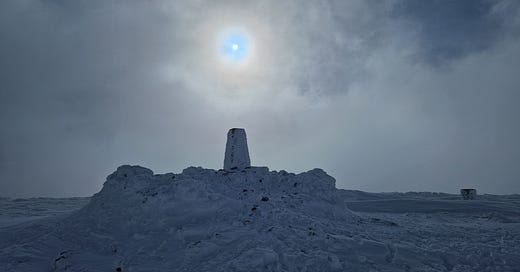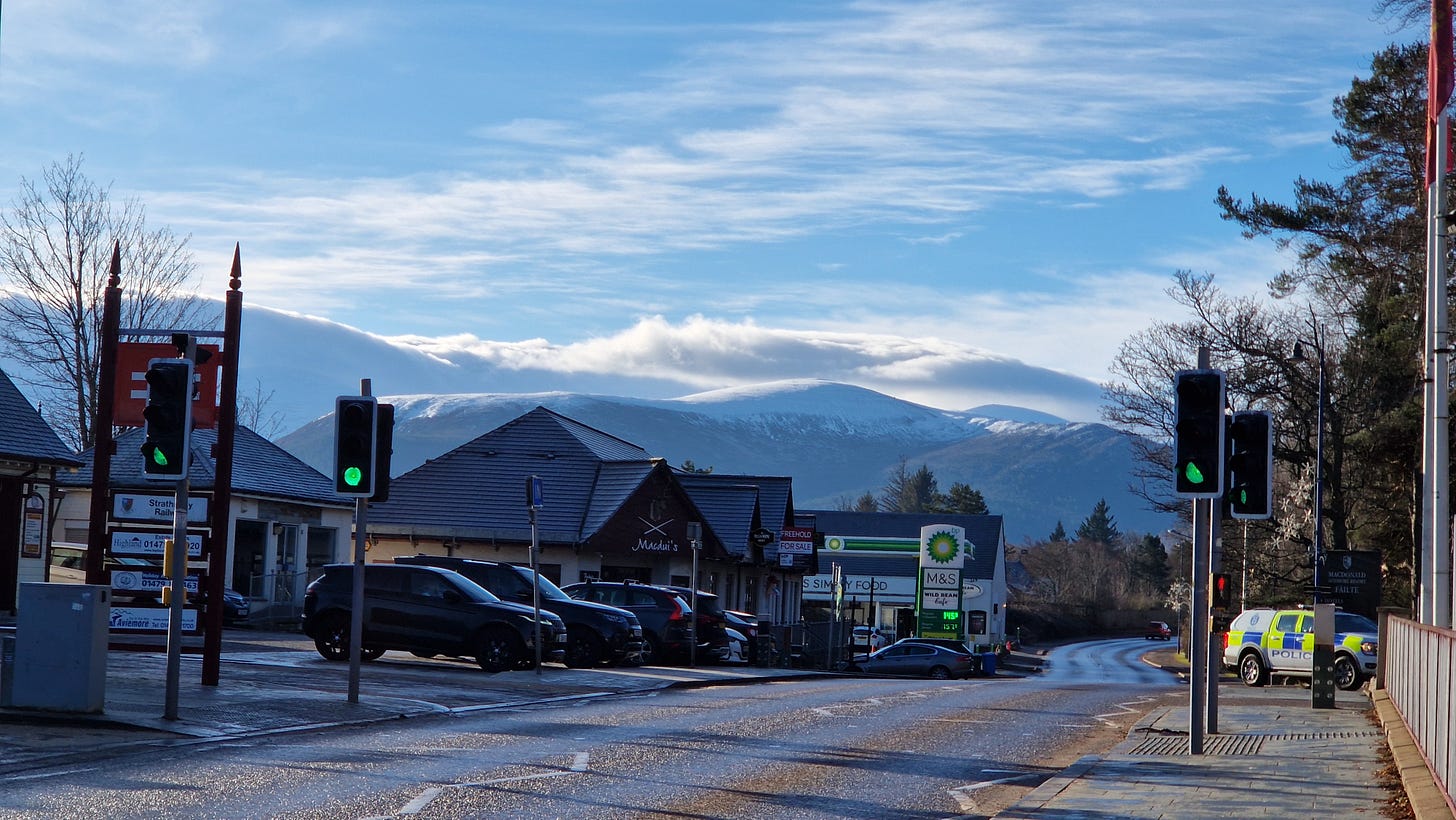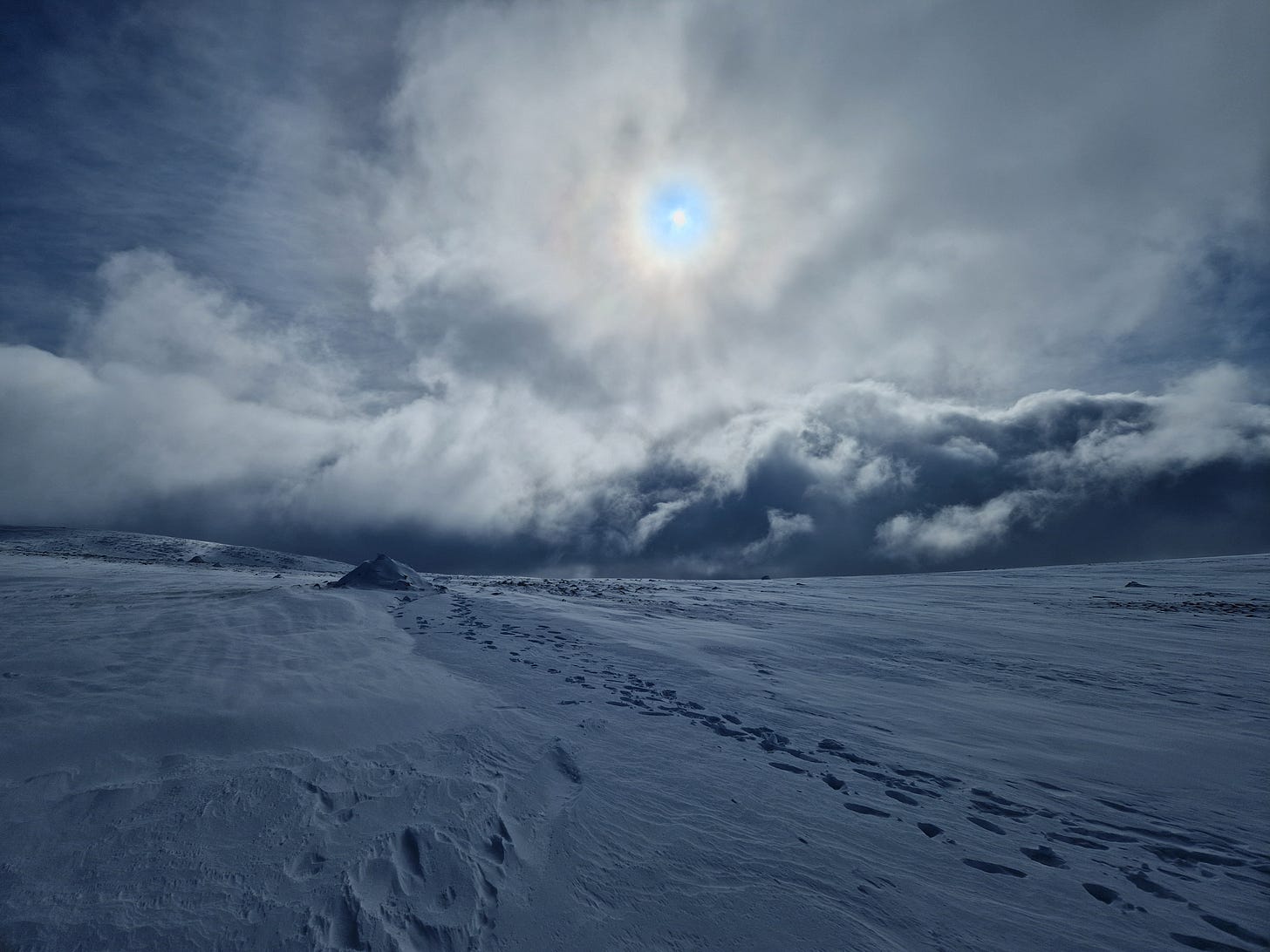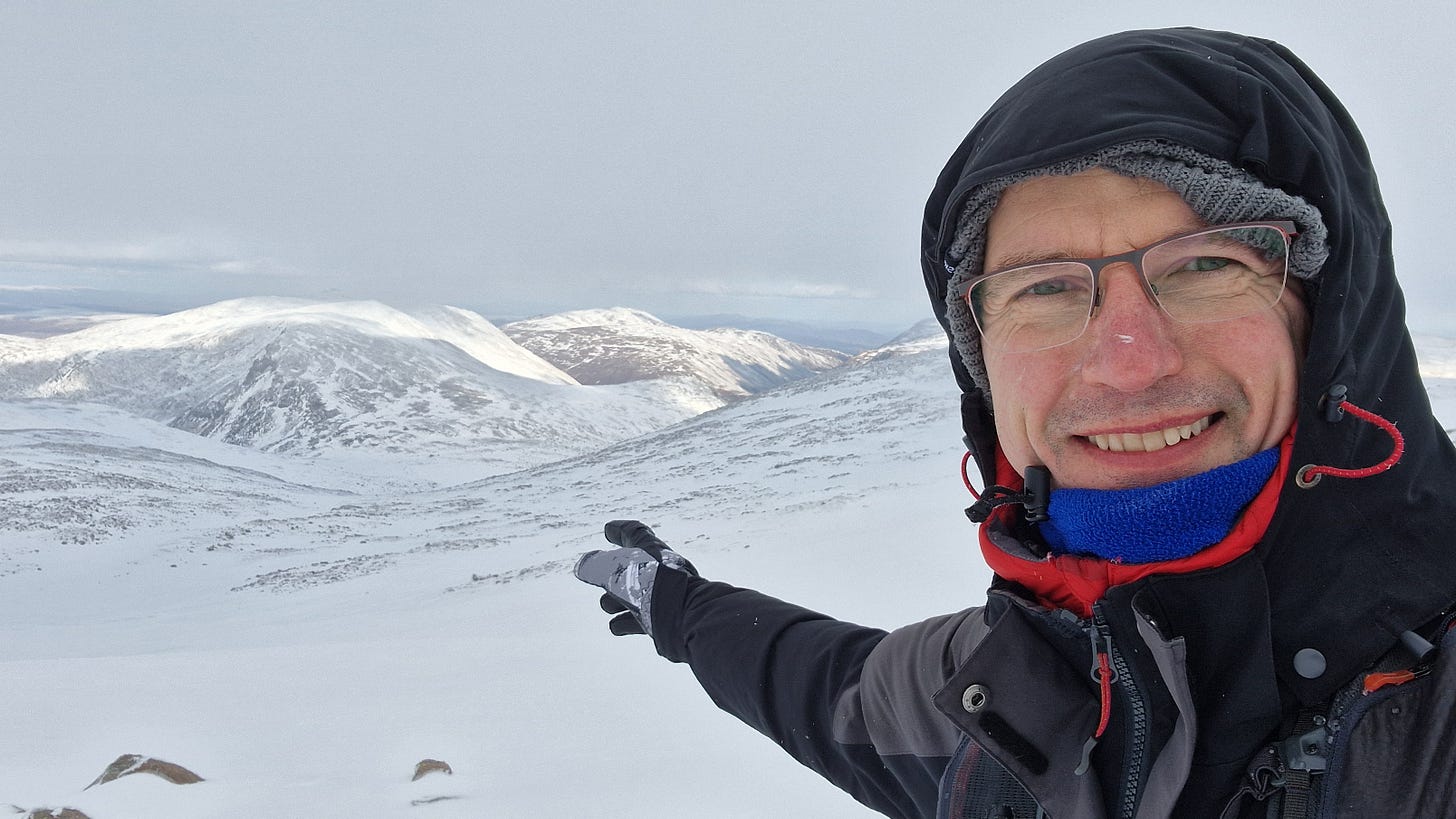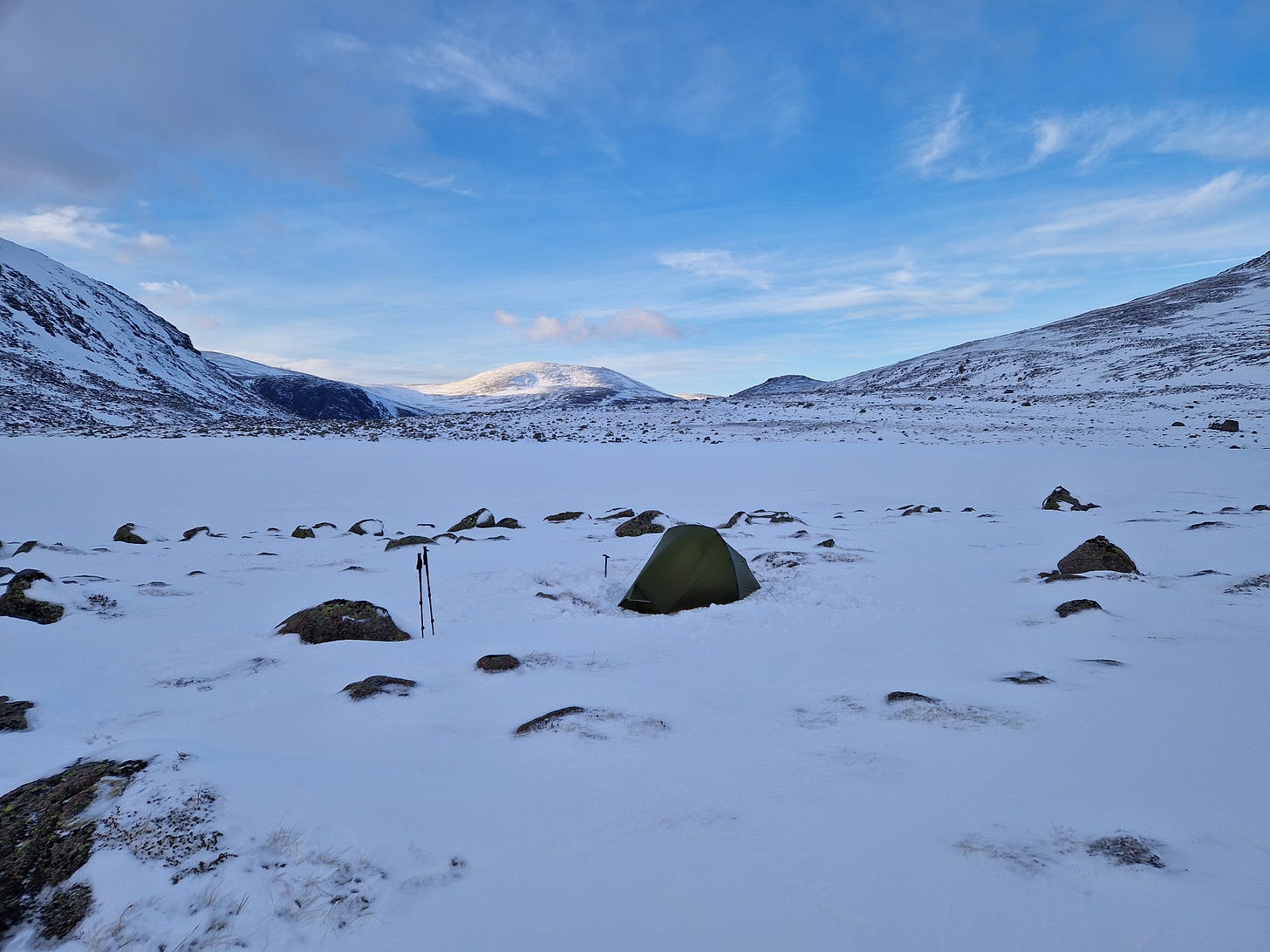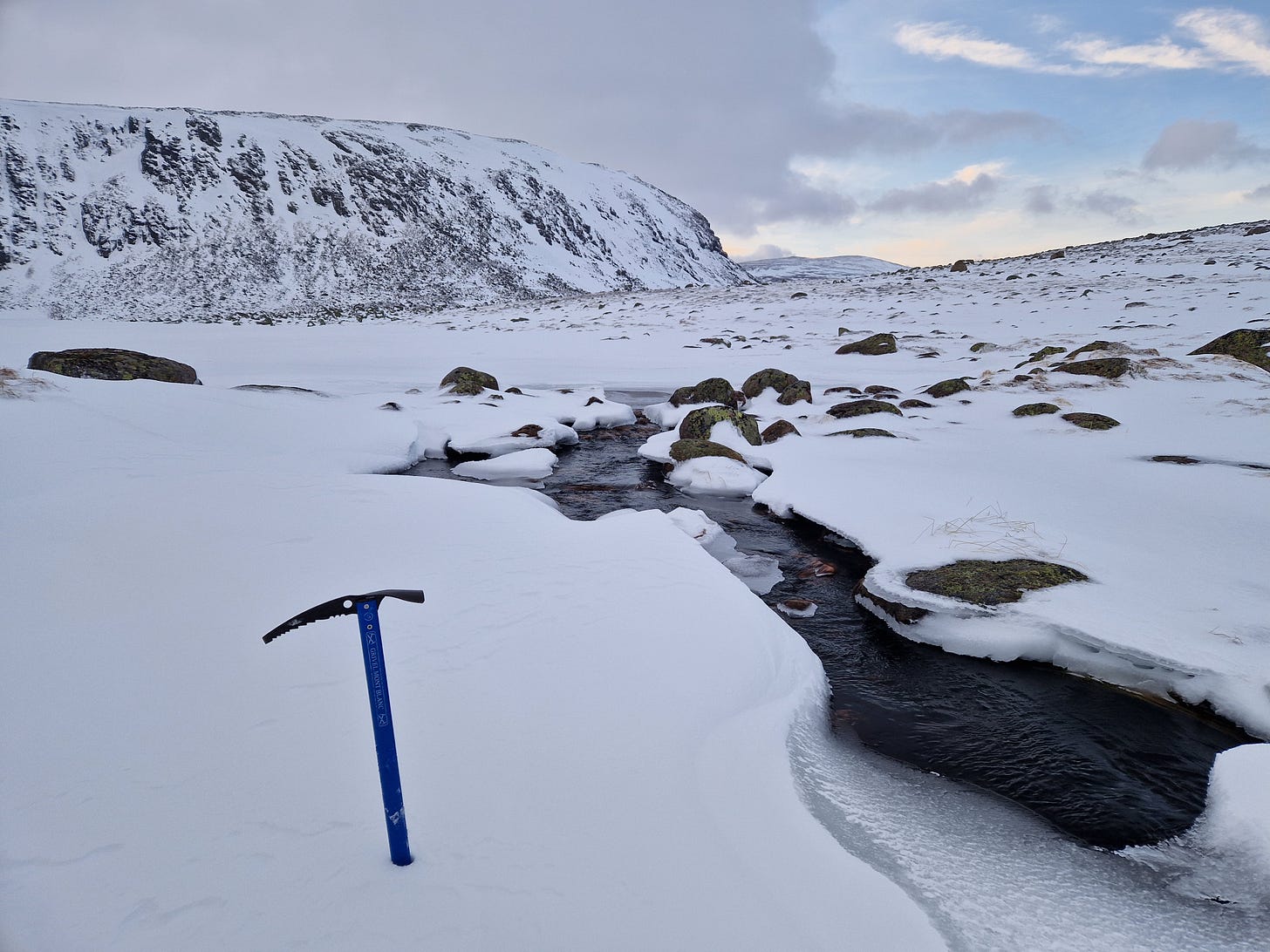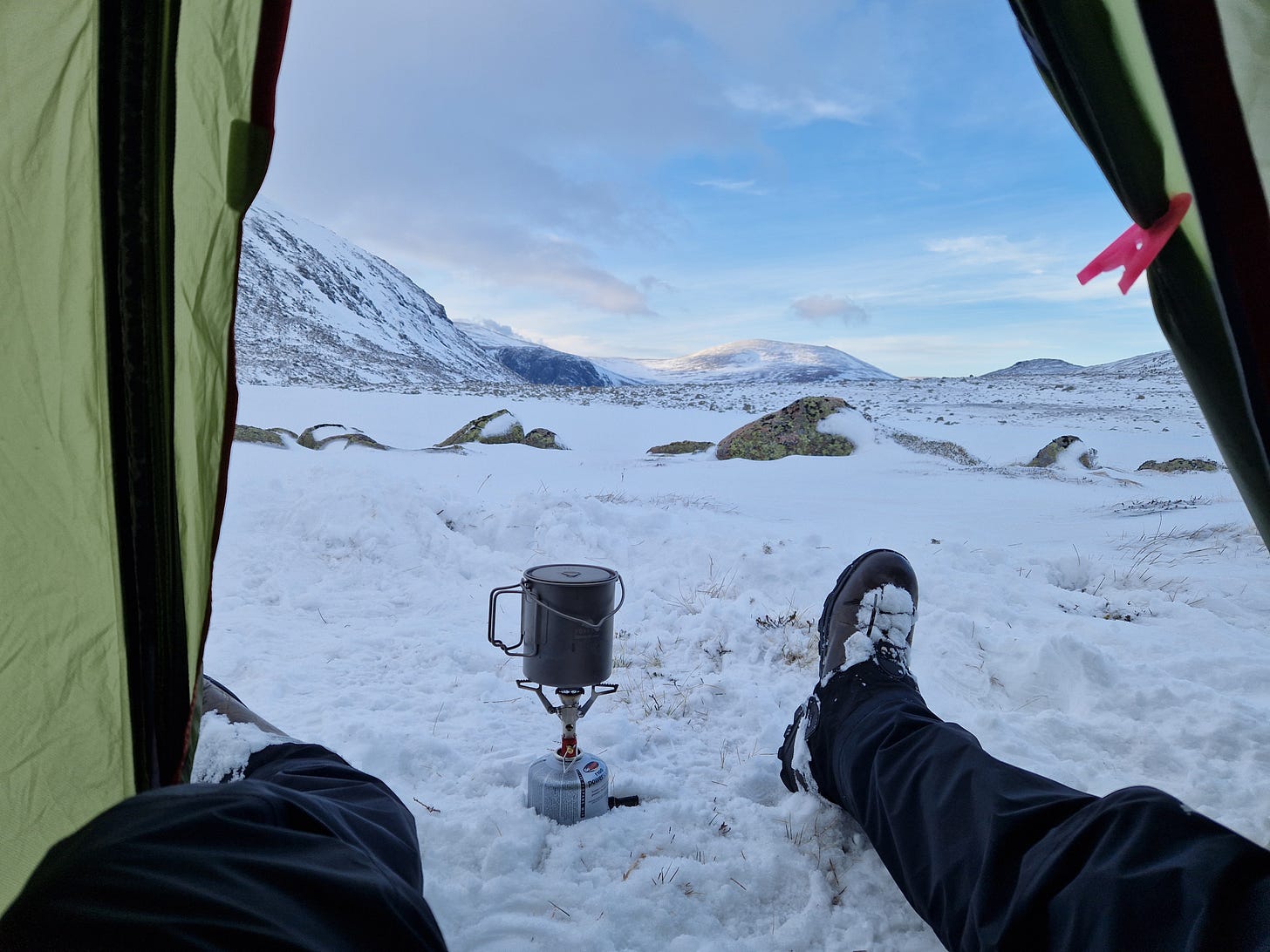Cairngorms Adventure Part 2: Cryosphere
Ascent of Ben Macdui and my first winter camp at 3000 feet
Following my Winter Skills course (Cairngorms, Part 1: Winter Skills), I had another three days in Aviemore before my train home. Although I’d booked a room in the Youth Hostel, I really wanted to explore the mountains with my tent. That evening, I checked the weather forecast and avalanche report using my recently acquired knowledge and planned a 19-mile route over Ben Macdui and Bynack More with a camp at 3000 feet. It would push my skills and equipment to the limit.
As well as practising using my ice axe and crampons, I was keen to experience the wonders of the remote Cairngorm plateau I’d only read about in books: Landmarks by Robert MacFarlane and The Living Mountain by Nan Shepherd. For any outdoor bibliophile, the Cairngorms loom large in the imagination, especially in winter. Macfarlane describes visiting his grandparents’ house on the northeastern slopes of the massif, where a framed Ordnance Survey map hung on the wall, and he would finger-trace walks done and planned. ‘My grandfather was a diplomat and mountaineer who had spent his life climbing around the world, and it was he and his Cairngorm world which cast the spell of height upon me as a child. His yard-long wooden-hafted ice-axe and his old crampons seemed to my young imagination like the props of wizardry.’
Shepherd describes walking in a crisp, bright, silent world except for the crunch of feet. And she is exquisitely entertained by watching the burns in the process of freezing: ‘Each is an interplay between two movements in the simultaneous action, the freezing of frost and the running of water. Sometimes a third force, the blowing of the wind, complicates the forms still further. She describes ice in all its forms: crimpled, crackled, bubbled, opaque, like hand-made paper, a scimitar blade, fluted, chiselled, translucent and transparent. ‘In short, there is no end to the lovely things that frost and the running water can create between them’.


As for me, I’d left it until I was 48 to reach that same world and picked one of the warmest winters on record, but now I was trained, equipped and stepping off the bus at the ski centre car park at 10 a.m. The weather was forecast to be dry with sunshine and cloud-banks to the south; wind gradually increasing during the day to 30mph, with gusts of up to 50mph by evening.
After a mile, I’d picked up the beginning of a long ridge and the snow line. I stopped to strap on my crampons using a small rock for support covered in glass-like ice, known as verglas. When discussing mountaineering the other day with my father, he told me that such ice can be perilous because it is so slippery. This would be the first physical manifestation of the vocabulary of our rapidly disappearing cryosphere.
As I gained altitude, another snow-word hit me like an icy sandstorm: spindrift – fine crystals of snow whipping down the slope. I’d occasionally read this word in hiking books, but I must confess, I thought it was just a fancy word for snow. However, experiencing it in my face, it’s no more snow than fine drizzle is a downpour. I was glad of my ski goggles. The same icy wind carved patterns in the snow: a comb, a canyon, a contour, a delta: Sastrugi. Although it sounds like a type of spaghetti, it is derived from the Russian word ‘zastruga’, meaning ‘wind-formed furrow’. As I walked, I attuned myself to the surface patterns and found that some patches (that had the appearance of dimples) were firmer and easier to walk on without sinking. The senses sharpened.
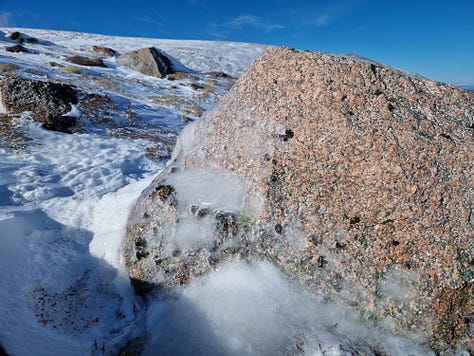
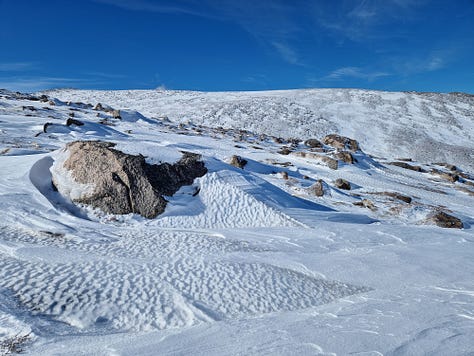
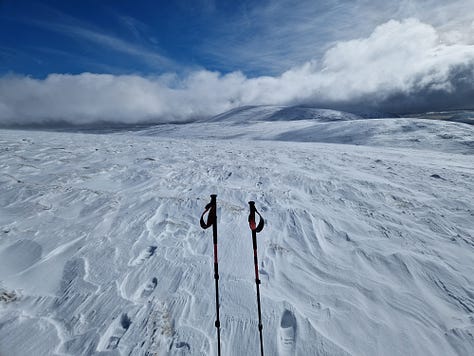
The ridge slowly morphed into a stony plateau and then into an alarming traverse with a thousand-foot drop to a tributary of the River Dee on my right. I was glad of my spikes underfoot. Also, I was quickly learning another lesson about hiking in snow – there are no paths or marks to follow; even tracks left by a party that overtook me rapidly disappeared. The landscape was a bleached map, constantly remade.
Somewhere on a vast expanse of scoured plateau, I crouched behind a pitifully small boulder for shelter to eat lunch. I regretted removing a glove immediately as my hand became painfully cold, and from then on, I resolved to keep my gloves on, no matter how cumbersome each operation. I didn’t attempt to make a wrap; I just stuffed a Polish sausage. Next, I put on my down jacket without removing my waterproof top. Ella, our winter skills instructor, had shown me this life-saving technique the previous day, saying, ‘If my top blows away in winter, it’s game over’. I managed the physical origami, just, and was grateful for her advice.
It was only five miles to the summit of Ben Macdui from the ski car park, but I always knew it would be slow going: uphill, directly into the wind, snow and ice underfoot, a heavy pack on my back. At just over three miles, I stopped and contemplated the view ahead. A dark bank of clouds rose on the horizon as foreboding as the horsemen of the apocalypse or the face of a tsunami. Unearthly shapes writhed within, like leviathan tentacles and behemoth eyes, while a watery sun haloed above. The wind was relentless. The terrain was unfamiliar. I felt absolutely alone. It was a point of intense indecision, and I was on the verge of turning back. But then I remembered a story Ella told us about a group of lads who froze to death trying to walk back from Ben Macdui one winter into a northerly wind. But today, the wind was reversed, so if I turned around, the wind would be at my back. I decided to give it another mile…
To my relief, the weather gods smiled, and in a shallow depression before the summit, the wind dropped. I caught my breath and took a sip of not-quite-frozen water. I was further encouraged by a group of Geordie hikers coming back down in high spirits who said it was clear on top. I made the final push and arrived at the summit trig point, which resembled a miniature snow-clad castle. The stone pillar itself was wrapped in feathers of wind-blasted rime ice. A cryogenic shroud.
The cloud had dropped to envelope the summit, so I took a compass bearing due east to find my way down to Loch Etchachan. I edged forward as I was taught in the scouts when walking in the cloud: waypoint by waypoint, in this case, a series of small black boulders, taking care not to stray over a cliff marked on the map dropping into a deep corrie. Soon, I was below the cloud and got my bearings. My destination, Loch Etchachan, lay frozen in a shallow depression while rolling snow-capped mountains circled the skyline.
As I approached my potential campsite, a helicopter flew up the valley and hovered over the loch before doing two or three circuits. The menacing noise, combined with my remote situation, made me feel like a fugitive in an action movie about to be gunned down. I wondered if the Youth Hostel had reported me missing even though I’d meticulously written up my route card before I left and handed it in, explaining I might be away for two nights. I stood frozen for around five minutes until the flying machine departed (unfortunately, we didn’t learn helicopter hand signals on my course so I couldn’t indicate I was ok without risking sending the opposite message). At last, I was left revelling in the isolation of what would be my frozen eyrie for the night and half wondering if the helicopter was a bad omen.
Although it was minus 5C down at the snow-covered loch, it was sheltered, so I scouted for a place to camp among the icy boulders. If the weather had been worse, my backup plan was to trudge down Etchachan Burn to the shelter of a bothie (Hutchison Memorial Hut), although I had been warned by a time-served Scot on the way up that bothies can be colder than tents.
I’d watched a few videos on YouTube about camping in the snow that advised clearing a patch with a shovel, or in my case, a foot, to create level ground. This I did before pitching my tent, finding it tricky to thread the thin pole with ski gloves on before securing the guy ropes with the 7-inch fluted stakes I’d bought to penetrate the snow. I stood back to admire my handy work. From a distance, my tiny tent was difficult to distinguish from the black boulders. A spec on the landscape, with the wall of the loch looming above.
Although the loch was frozen solid, I hoped I might find running water where the burn flowed out to save me from melting snow. I negotiated my way around the shore of the loch that seamlessly merged into snow-covered ice until I reached a flattish area close to where the helicopter had landed. I heard it first, a faint trickle, and then saw a slushy vermiculate depression worming its way under the snow before briefly emerging: black as ink, cold as death, liquid on the cusp of freezing. Just like Nan Shepherd promised, the interplay of ice and running water created fascinating forms.
I filled my bottles, trying not to get my glove wet, and trudged back to my tent. I was alarmed to see ice crystals forming in the water, so I got my stove out to heat water for dinner as quickly as possible. I had a magical view from my tent and attempted to absorb the moment, something that is easier said than done when focussing on survival. The sky turned a gentle shade of peach above snowclad Bynack More, the mountain that would form part of tomorrow’s adventure. Looking back on it now, nearly a month later, I still can’t quite believe I was really there. ‘The stuff that dreams are made of’, to misquote Shakespeare.
Thanks for reading.

